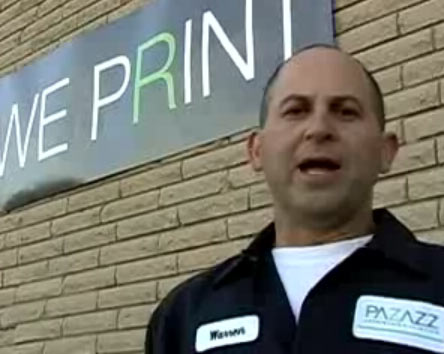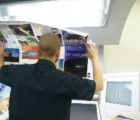
Australian Print Workshop (APW) in the bohemian, inner-city Melbourne suburb Fitzroy is an energetic, contemporary workshop that uses time-honoured printing crafts. Limited editions – printed from copper intaglio plates, from limestone blocks or from litho plates, woodblocks, lino blocks, engraved woodblocks and embossed plates – greet ProPrint in APW’s gallery.
Then there’s the studio, a serene space that meets the visitor’s eye through floor-to-ceiling glass windows, from which antique, but fully functioning, printing presses add a dash of vogue to fashionable Gertrude Street.
It’s an incorporated, not-for-profit arts organisation. “We’re perhaps the cousins of the people you speak to [at ProPrint],” reflects director Anne Virgo. “We specialise in what’s sometimes referred to as the ‘dinosaur’ print technologies.”
Martin King, APW’s senior printer, has an art-school background, while printer Simon White comes from the trade side of the industry. They are maestros of the kinds of machinery you would normally see only in a commercial printer’s reception foyer.
There is a donated Columbian press from the 1860s, a couple of Albions from the same era, hand-operated lithographic and intaglio presses. “It’s labour-intensive,” says Virgo. “We might make only five prints in a day.”
Virgo has heard that APW once received cast-off Bavarian lithography blocks from the Victorian Government Printer. The stones are renewable resources, as impressions can be grained away repeatedly. “We have more than 100 of these stones, ranging from A4 size to monsters that need forklifts to move,” says Virgo.
“There’s a story that the earliest of these came to Australia as ballast in sailing ships,” she adds. Printers commandeered them, goes the yarn, but when the trades changed, some became backyard pavers.
But not all went underfoot. APW once owned a block engraved with the front page of the Argus newspaper, an image of a Victorian-era woman clad in a feather hat. “We took a few prints of that before the stone was grained.”
Artists working with APW draw their creations directly on the stone using lithographic crayons and washes, much in the way litho was conceived by Senenfelder in the 19th century. Intaglio etching is another specialty, with artists preparing a sheet of copper plate, applying grounds to the plate, then drawing their image through those grounds with various instruments and techniques.
The plates are individually etched in an acid bath, processed, inked up and printed – all by hand. “Sometimes we get printing industry people through, who may have done a ‘pre-digital’ printing apprenticeship in their youth, and their eyes light up in recognition,” says Virgo.
The workshop also prints from lithographic plates and has a Fag offset press. Several of these icons were imported into Australia in the 1980s – Show Ads owned one, using it as a proofing press.
Virgo describes the collaborative “dance” between artists and craft printers. “A printer in this industry doesn’t just have to be a masterful technician with the machinery; they have to know how to engage with an artist. Our printers are collaborators who don’t have a voice in the image other than the technical expertise that makes that image happen. For every colour, it’s a different drawing on a different plate or stone that needs to be printed in sequence.”
Aside from its gallery and printing studio, APW runs education programmes. A one-year resident trainee printer is currently learning the craft. Night, weekend and summer-school courses attract graphic designers, but also “doctors, dentists and schoolteachers”. These classes are open to anyone who wants to learn the art of printmaking.
The workshop has won three National Print Awards, including a gold award in the Small Business category in 2007. APW’s artists are a “who’s who” – names such as Rick Amor, Tim Maguire and Louise Weaver, and Aboriginal artists such as Kitty Kantilla, Rosie Karadada, Pedro Wonaeamirri and Butcher Cherel Janangoo.
An exhibition of 30 of its prints opened at the Aichi Prefecture Gallery in Nagoya, Japan, in June this year, marking 30 years of a sister-state relationship between Victoria and Aichi. Last year, the British Museum acquired 119 of APW’s prints for its permanent collection. A few years ago, the National Gallery in Canberra curated an exhibition of APW’s prints and published a book on the workshop.
APW also takes its workshop on the road and has worked with artists in indigenous communities throughout Australia, including in Arnhem Land, the Kimberley, Central Desert, Melville Island and the Torres Strait islands.
The workshop began in a North Melbourne craft centre in 1981, then moved to Fitzroy in the mid-1980s. Later that decade, it shifted to its present location. With financial assistance from the Sidney Myer Fund, Ian Potter Foundation, Helen Macpherson Smith Trust, ANZ Trustees, Collie Print Trust and the Gordon Darling Foundation,
APW bought the building. It reopened in March this year after a $2m renovation. Virgo, who has been involved with APW for 16 years, has realised her dream of translating her passion for printed art into a living workshop.
Melbourne Museum of Printing
The Melbourne Museum of Printing (MMoP) is a time capsule of printing and typography, where founder Michael Isaachsen and other volunteers hold workshops for graphics students, industry groups, and beginners.
The museum, in 370m2 of rented space in Footscray, nestled among trendy offices a hop from the Maribyrnong River, is a relic defying the real estate boom – and too small to house more than a fraction of the collection, claimed to be one of the most comprehensive in the world in its field. The rest is in numerous warehouses where it is largely inaccessible. “This makes it hard to maintain the interest of volunteers,” Isaachsen commented.
He is hoping to consolidate the museum to a more spacious facility, where this kit can be showcased. But, even with revenue from the classes, he laments a lack of funds might jeopardise the museum. A support group raised $30,000 last year, and that saved the museum at the time, but Isaachsen says he wishes the museum received more support from the printing, publishing and design industries.
Isaachsen set up what was to become Australia’s last type foundry in 1977, as a ‘heritage industry’ to ensure the availability of movable types. In 1993, when commercial realities bit, the print enthusiast, who bought his first table-top press when he was just 11, morphed his hot-metal shop into a not-for-profit museum.
On the night ProPrint called at MMoP, the Lithographic Institute of Australia was visiting, and Isaachsen gave a presentation on movable type, peppered with talk of ‘ems’ and ‘picas’, leading and kerning, and offering lots of hands-on time with types, matrices, slugs, fonts and galleys.
Among the memorabilia on display was a Monotype hot-metal typesetting system. A paper roll
conveying character and layout information is produced on the Monotype keyboard. The system was invented by Tolbert Lanston in the USA around 1890. The punched roll is then read by the Monotype composition caster which produces an individual metal type for each row of holes on the tape.
The visitors then saw two other hot-metal typesetting machines that produce each line of type as a single piece (a ‘slug’) instead of separate letters: a Mergenthaler Linotype which casts from a line of matrices assembled via a keyboard and a Ludlow Typograph which casts from matrices assembled by hand, skilfully operated by museum volunteer Laurie Harding, another ‘old hand’.
The most vintage hardware on the premises is an Albion press, made by Wilsons of London in 1849. It is a simple hand-operated press. There are more advanced presses available for visiting artists to use, but many prefer to know that they are using technology very similar to the original press invented by Johannes Gutenberg in 1450.
Like the other pieces, the old press responds to meticulous maintenance. “We make sure each piece is in working order,” he says, “otherwise there’s not much point to showing people through.”
Isaachsen adds: “It’s time for some serious sponsorship or philanthropy, or the museum cannot continue.
“No one has put their hand in their pocket. I’ve been speaking to printers, suppliers, government and philanthropists but I really need someone other than myself to generate the interest. Up until now, I haven’t found anyone who has been able to put the case to these industry people and government,” adds Isaachsen.
So why haven’t Isaachsen’s previous predictions of closure and destruction come to pass? Members of his family have supported the project – “despite sensible advice” – by selling and mortgaging
their assets. “But it’s not fair that the industries for whom the museum exists allow private individuals to impoverish themselves like this,” he says. Isaachsen adds that despite limited help, landlords have already destroyed many machines and other items and more is expected if no help materialises.
Information
AUSTRALIAN PRINT WORKSHOP
www.australianprintworkshop.com
“Australian Print Workshop is a unique centre providing both established and emerging artists with access to a wide range of printmaking equipment and expertise in the context of a world-class printmaking workshop.”
Director Anne Virgo
Phone (03) 9419 5466
Email auspw@bigpond.com
Address 210 Gertrude St, Fitzroy VIC
MELBOURNE MUSEUM OF PRINTING
www.printingmuseums.com/museum
“Australia’s working and teaching museum of typography and printing located at Footscray, Victoria. Specialising in retention of traditional printing, both the equipment and the knowledge.”
Curator Michael Isaachsen
Phone (03) 9689 7555
Email curator@printingmuseums.com
Address 36 Moreland St, Footscray VIC
Comment below to have your say on this story.
If you have a news story or tip-off, get in touch at editorial@sprinter.com.au.
Sign up to the Sprinter newsletter


